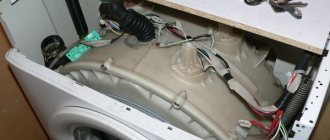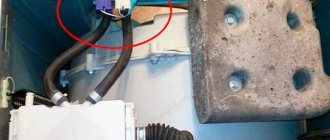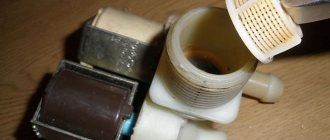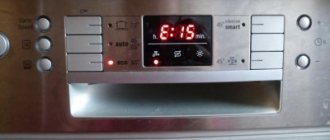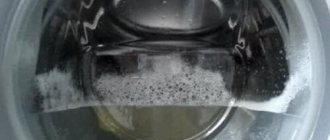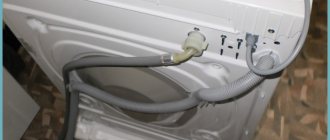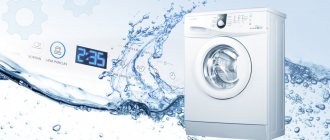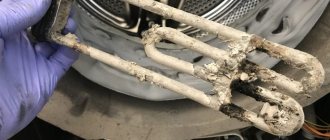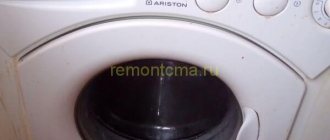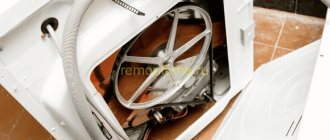You decided to do another wash, opened the hatch of the washing machine to put in dirty clothes, and discovered that there was water in the machine. It’s even worse if the water is not only in the washing drum, but also in the form of a puddle on the floor. But where did she come from? After all, all this time the machine was disconnected from the network! Perhaps this is a serious breakdown and you will have to call a repairman? Don't rush to conclusions. Let's take a closer look at this problem and how to eliminate it.
Causes of malfunction
The first step is to find out the cause of the malfunction. Let's consider two sources through which water can enter the drum of a washing machine when it is turned off. The first is a sewer pipe, the second is a water pipe. We study the nature of the liquid; if the water is cloudy or has an odor, it comes from the sewer pipe; if it is clean, it comes through the water supply.
Malfunctions, depending on the water source:
- Malfunction of the electrovalve, which is responsible for the water supply;
- Missing or malfunctioning siphon valve;
- Incorrect connection of the washing machine to the sewer;
- The drainage system or drain is clogged with debris, causing water to back up into the drum.
What malfunctions cause water to get into the turned off washing machine?
0
Source:
When the washing machine is turned off, water can accumulate in various parts and components. Let's consider the malfunctions that are directly related to this phenomenon.
- The appearance of sewer water. Wastewater often ends up in the washer if it is not connected to the sewer properly. First of all, you need to check the location of the drain hose - whether its installation complies with the manufacturer's recommendations. All deviations must be eliminated. If the connection is in order, then it is possible that the cause is a clogged pipe. Water that should go down the drain accumulates over time and goes back into the car, since it has no other way out. You can remove such a blockage yourself.
- The appearance of tap water. The cause of the malfunction lies in the intake valve. For example, it can become clogged due to many small stones or sand. In addition, the valve wears out over time and fails. It must be cleaned or replaced if it is completely unusable.
- Water in the drum. If liquid appears in the loading hatch of the washing machine, then most likely the drain pump has broken down or the drain system has become clogged. To do this, you need to check the pump filter, where dirt may have accumulated. If it's clean, then it's all about the pump. In this case, the “washing machine” behaves like this: it suddenly stops working, but resumes the process when it is restarted. The pump needs to be checked on time, since in this mode it will not last long.
- Water in the detergent compartment. The rinse aid compartment can become very full of water if, for example, the machine is not level. Then the liquid will inevitably remain inside the tray. The cause of blockage in the dispenser grid (and therefore accumulation of water) can be low-quality detergents. Also, the dispenser may be damaged due to weak water pressure, which did not remove all the powder from the tray.
Diagnostics
The water in the drum is cloudy and has a characteristic odor; we check the drainage system step by step:
- The drain hose is not fixed or installed at a level below 60 centimeters. If the hose is not secured to a special bracket (see photo below), water from the sewer will flow into the washing machine;
- The washing machine is connected to the siphon of the sink or bathtub. The siphon periodically gets clogged; while using the sink or bathtub, the water does not have time to drain into the sewer and ends up in the drain hose, then into the washing machine tank.
- General blockage of the sewer system. In this case, the water should not drain well at the connection point of the washing machine. For example, in a bathroom, toilet, sink or washbasin. It all depends on the connection option for the washing machine. If the blockage is common, the water does not have time to be discharged into the general sewer and enters the washing machine under pressure. A siphon valve solves this problem.
If the water in the tank is clear, your water supply valve is faulty. In this case, it is easy to diagnose a breakdown; turn off the water supply valve and the flow of water into the tank should stop. The valve cannot be repaired; it must be replaced with a new one. See also -
LG washing machine displays DE error - what does it mean?
"RemBytTech" - professional repair of washing machines with a guarantee
If you are not sure that you can cope with the trouble on your own when a switched-off washing machine fills with water, call the RemBytTech workshop and entrust the repair to professional craftsmen.
Company advantages:
- telephone consultation;
- qualified craftsmen;
- repairs at your home within 24 hours after your request;
- free diagnostics (if the repair is carried out by our technician);
- Warranty up to 2 years on all spare parts and work performed.
How to fix
We will not describe in detail how to clean a sewer in this article. Disassembling and washing the siphon is not a difficult task. If you don’t want to do it yourself, call a regular locksmith, he will help. This also applies to drain cleaning. We recommend that you read the material on how to connect a washing machine if you have a problem with the connection.
Before starting repairs, be sure to turn off the water and disconnect from the network. Replacing an electronic valve is a simple repair and we will help you with this.
For your information! A broken water supply valve is a warranty issue. If you repair it yourself, you will lose your warranty, if you still have one.
Front loading machine, the simplest case:
- We remove the top cover of the washing machine; most often it is enough to unscrew two bolts from the back;
- We remove the electrical supply terminals and disconnect the hoses, unscrew the screws that secure the valve to the body;
- Install the new valve in reverse order. Make sure to ensure the polarity of the connected wires and do not mix them up.
In top-loading washing machines, you have to remove the back wall, and sometimes you have to remove the entire body. In any case, it all comes down to the fact that you need to get to the valve, the valve is located where the water is supplied to the washer. Remove the valve and install a new one.
Important:
We do not recommend repairing the valve; it is easier to purchase a new one. But repairs are possible, watch the video below “How to disassemble the valve.”
Take your time to close the lid or assemble the washer body. We carry out the test step, connect the water supply hose and start any wash to check its functionality.
Water appears when the unit is operating
When parts of the drain system break, partial drainage occurs. Sometimes the liquid does not drain at all and remains in the drum.
The drain filter is clogged
The wash is finished, but there is still liquid in the centrifuge. This problem occurs due to a clogged drain filter. Sometimes small parts in the form of coins, paper clips and buttons get into it.
To clean it, you need to:
- Drain the liquid in the hose.
- Unscrew the filter. To do this, the cover located at the bottom of the body is removed, the part is unscrewed and washed.
- Check the pump located behind the filter for clogging. To do this, you need to start the drain mode. The pump blades should rotate freely. If their movements are difficult, then the pump is clogged with dirt and should be cleaned.
- Insert the filter back and turn on the drain function. If the reason was a contaminated drain, then the system should be fully operational.
Read more ► Why the washing machine does not drain water and does not spin clothes
Broken pump
The blockage creates a favorable environment for the emergence of microbes and an unpleasant odor.
The machine makes a lot of noise and tries to drain the liquid, but to no avail. The pump may be broken or clogged with dirt.
You can check its operation as follows:
- Remove the filter and inspect the pump for dirt.
- If no dirt is found, turn on the drain mode.
- The pump blades should rotate. If this does not happen, a major overhaul is necessary.
To repair a part, you need to call a technician who will replace the broken part with a new one. The load on the pump increases when the drain hose is artificially lengthened.
Precautionary measures
Some tips on how to avoid such problems:
- Install a tap that will regulate the water supply. It can be opened before washing and then closed accordingly. The method is not for the lazy; according to experts, the intake valve will last longer;
- Install the siphon valve. This will help prevent sewage water from entering the drum;
- It is advisable to use a leakage protection system that is installed on the floor. Your neighbors will thank you.
We hope our article helped you solve the problem. Write a comment or share the article on social networks, we will be pleased!
See also:
- 7 best washing machines under 20,000 rubles according to customer reviews
- 8 best narrow washing machines according to customers
- 8 best BEKO washing machines according to customer reviews
- 10 best washing machines from Samsung
- 10 Best Top Loading Washing Machines
What does this mean?
According to the instructions for the washing machine, its internal elements must be kept dry between washes. First of all, this applies to the drum where dirty things are loaded.
If the washing machine fills with water when it is turned off, this can lead to the following problems:
- the spread of an unpleasant odor in the room where the machine is installed;
- the formation of fungus and mold on the inner walls of the drum;
- gradual rusting of the metal elements of the device;
- danger of water pouring out of the washing machine onto the floor of the apartment.
Based on this, it is necessary to take this problem seriously and make every effort to eliminate it.
What to do?
As soon as you discover a malfunction of the drain valve, you should immediately stop the water supply. Disconnecting the washing machine from the power supply will not help here - you must shut off the water pipes, otherwise a flood cannot be avoided.
A broken intake valve is not a case where you need to contact a professional repairman; you can deal with this problem on your own.
Related article: Attic interior with a gable and sloping roof - the design of your dreams!
So, a broken water intake valve must be replaced, but to do this you first need to remove it. To get to this part, you need to remove the panel under which it is located (top or side, depending on the type of load). Having found the valve, disconnect all hoses and wires going to it. Then unscrew the bolts securing the valve (or unfasten the latches) and remove the faulty part. To carefully pull out the valve you need to turn it slightly.
Instead of a broken device, install a new spare part in its place. Then do all the steps in reverse order. To make your task easier, when you start working, take pictures of each stage, then you can easily assemble everything as it was.
For more information about this, see the following video tutorial.
Breakdown of the pressure switch
This device detects the water level, and when it reaches the value corresponding to the washing cycle, a signal is sent to the control module. Which, in turn, turns off the valves and water stops flowing into the machine.
A faulty sensor does not determine how full the tank is. As a result, water flows continuously. The pressure switch rarely breaks!
Breakdown may occur over time. The inner membrane has hardened and lost its ability to bend. In this case, replacement with a working one is necessary.
Sometimes the contacts oxidize and the signal does not pass through. After cleaning, you need to check the functionality.
The rubber tube may also become clogged or cracked. After replacing or cleaning, the problem will disappear.
One option is an electronic pressure switch
Safety measures against such leaks
If the solenoid valve breaks down, water will be drawn into the tank until it begins to spill out onto the floor, flooding the bathroom and neighbors. Therefore, we should protect ourselves from the occurrence of such malfunctions. We cannot foresee a breakdown, but we have the opportunity to install a small crane at the entrance to the machine . Once the machine has completed the wash cycle, the tap can be closed, thereby preventing possible water leakage.
For safety reasons, the tap is installed directly after tapping into the main pipe - this will help prevent possible leakage in the event of a rupture of the inlet hose. But you need to remember that the tap should be in the most accessible place. Many people neglect to install a faucet, believing that they can do without it. But will these people be able to quickly run to the public tap in order to completely shut off the water supply to their house or apartment? It is the operational approach that will help us avoid accidental accidents.
How to avoid unauthorized water collection
The main way to get rid of this situation is not to provoke its occurrence, which can only be achieved by proper installation of the filling and draining paths. The rules are simple.
- Be sure to install a separate faucet for the washing machine. This way your device will always be under control. One movement and a flood will not happen.
- In any case, place the loop of the drain hose at the level of the sink, or, in extreme cases, the bathroom.
If the leak from the water supply is insignificant - it takes more than a day or two for water to reach the lower edge of the loading hatch, be sure to turn off the supply tap during downtime. This way you can delay the repair process indefinitely.
Control block
In a modern automatic washing machine, all components are controlled by an electronic module, which is essentially a computer with software. If the valve circuit is damaged, the controller does not turn them off and water is constantly drawn in.
In this case, two options are possible:
It is not always possible to find a new module that matches the SMA model. Sometimes you need to wait 2-3 months. In addition, it needs to be flashed with a program. He won't work without it. It's like a computer without Windows.
For restoration, it is best to contact a specialized washing machine repair service.
SMA control module
Let us note right away that this breakdown is not typical for any particular brand, but is inherent in all SMAs: Samsung, LG, Bosch, Electrolux, Zanussi, Ariston, Indesit, Virpull. , "Kandy", "Hansa", Gorenje, "Ardo", "Beko", "AEG", "Miele", "Siemens", "Kaiser" and "Atlant".
